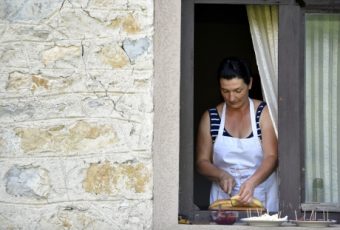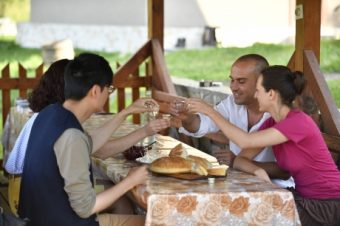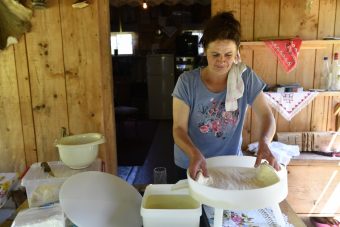Danka Sekularac from northern Montenegro lives a life off the grid. Her house runs on solar power. The water is fetched from a nearby stream. Her food is homegrown.

Her surroundings – the mountain ridges of Biogradska Gora National Park with its sprawling pine forests, rolling meadows, pristine streams and glacial lakes – exude an air of a world untouched.
But life can get tough here.
Smallholder farmers like Danka used to rely heavily on agriculture. So much so, that a bad blueberry harvest or honey season could be enough to put their livelihoods at risk. Opportunities were scarce, and young people moved or were tempted to move elsewhere.
But with help from FAO and the European Bank for Reconstruction and Development (EBRD), opportunities started opening up.
Some 100 smallholder farmers from mountain villages in northern Montenegro are now reaping the benefits of agro-tourism and/or getting recognition for preserving centuries-old culinary traditions, and a way of life that, elsewhere, has been long abandoned or is slowing dying out.
30-year-old Danka hosts tourists, mostly from other parts of Europe, in “katuns” – centuries-old wooden huts used in the past by nomadic herders. She offers them guided hiking and horse riding, lessons in cheese making, and enthralls them with fresh, organic food.
“We have organic food, always organic. We have blueberries, mushrooms, actually everything. We do not buy anything at the market. That’s the best because we make the food with our hands and we know how it’s made. And it’s very delicious for tourists,” says Danka.
“This is the first year of the tourist season, and it’s a very good season. July was completely full with guests. I did not expect so many guests… My life changed a lot. I have maybe to work more and harder, but it’s very nice because I meet different people and can earn money,” she adds.

The FAO-EBRD project staff has worked with ministries, non-governmental organisations, tourism agencies, hotels and restaurants in Danka’s area and nearby municipalities to promote agro-tourism and local, high quality foods.
Through the project, farmers got connected with restaurant and hotel owners; and farmers and chefs got trained in how to store and cook local products so that their unique quality was enhanced and food safety compliances were met – all with the aim of encouraging locals to keep their traditions alive whilst boosting their incomes.
“Serving traditional dishes directly supports the farmers. Our potatoes, veal, fruits, vegetables and dairy products are all sourced from the local farmers,” says restaurant owner Plana Pejovic who took part in the FAO-EBRD training.
A typical lunch at her Serdar Restaurant near Mojkovac would consist of fresh cream cheese and creamy mushroom soup served with potatoes and cheese. At the entrance, the restaurant also sells blueberry juice, honey and other local products to visitors.
Elsewhere in northern Montenegro, FAO and EBRD, with funding from Luxembourg, helped farmers get international recognition – Geographical Indication (GI) status – for some of their foods thanks to their high quality and unique production process.
Crnogorska Govedja pršuta (Montenegrin dried beef meat) and Crnogorska Stelja (Montenegrin dried and smoked sheep meat) received GI status in 2018.
Inspired by the project, five additional products have been registered as GI, including Kolasin Lisnati sir (layered cheese), which is produced mainly by women.

To get the GI certification, the project staff worked with farmers, food processors and local authorities to help them upgrade their products’ food safety and quality standards. This included helping producers develop and agree on a code of practice that they must respect in order to sell their products under the GI label – for example, the food must come from the designated areas, and high quality and hygiene standards must be upheld. The project has also supported policy dialogue and development of appropriate food safety standards in the meat sector at the national level, and raised producers’ and consumers’ awareness about the new standards.
The GI-labelled dried beef, for example, must be made from the best cuts of fresh beef fed mostly on grass, salted with sea salt, beechwood-smoked and dried in the mountain air. This gives the meat its distinctive dark plum colour, consistency and texture and prevents any bitter taste.
“I have been involved in meat production – beef prosciutto and sheep meat – from an early age because my ancestors, my grandfather and grandmother were also doing this,” says meat producer, Almir Aldrovic.
“I’m very excited about receiving the GI certification because this will give us new opportunities, open new markets and businesses,” he adds.
By supporting local traditions to build better livelihoods and empower communities, FAO and its partners are working toward a world free of poverty and hunger.
Source: FAO





